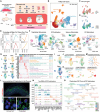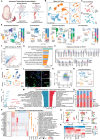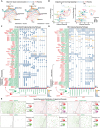Cross-Species Insights into Trophoblast Invasion During Placentation Governed by Immune-Featured Trophoblast Cells
- PMID: 39234818
- PMCID: PMC11558115
- DOI: 10.1002/advs.202407221
Cross-Species Insights into Trophoblast Invasion During Placentation Governed by Immune-Featured Trophoblast Cells
Abstract
Proper development of the placenta, the transient support organ forms after embryo implantation, is essential for a successful pregnancy. However, the regulation of trophoblast invasion, which is most important during placentation, remains largely unknown. Here, rats, mice, and pigs are used as biomedical models, used scRNA-seq to comparatively elucidate the regulatory mechanism of placental trophoblast invasion, and verified it using a human preeclampsia disease model combined with scStereo-seq. A dual-featured type of immune-featured trophoblast (iTrophoblast) is unexpectedly discovered. Interestingly, iTrophoblast only exists in invasive placentas and regulates trophoblast invasion during placentation. In a normally developing placenta, iTrophoblast gradually transforms from an immature state into a functional mature state as it develops. Whereas in the developmentally abnormal preeclamptic placenta, disordered iTrophoblast transformation leads to the accumulation of immature iTrophoblasts, thereby disrupting trophoblast invasion and ultimately leading to the progression of preeclampsia.
Keywords: iTrophoblast; placentation; preeclampsia; trophoblast invasion.
© 2024 The Author(s). Advanced Science published by Wiley‐VCH GmbH.
Conflict of interest statement
The authors declare no conflict of interest.
Figures






References
MeSH terms
Grants and funding
- 2023B1212060057/Science and Technology Program of Guangdong Province China
- 2023A1515030193/Guangdong Basic and Applied Basic Research Foundation
- 2021YFD1301103/National Key Research and Development Program of China
- 2023XBH00004/Guangdong Provincial Promotion Project on Preservation and Utilization of Local Breed of Livestock and Poultry
LinkOut - more resources
Full Text Sources
